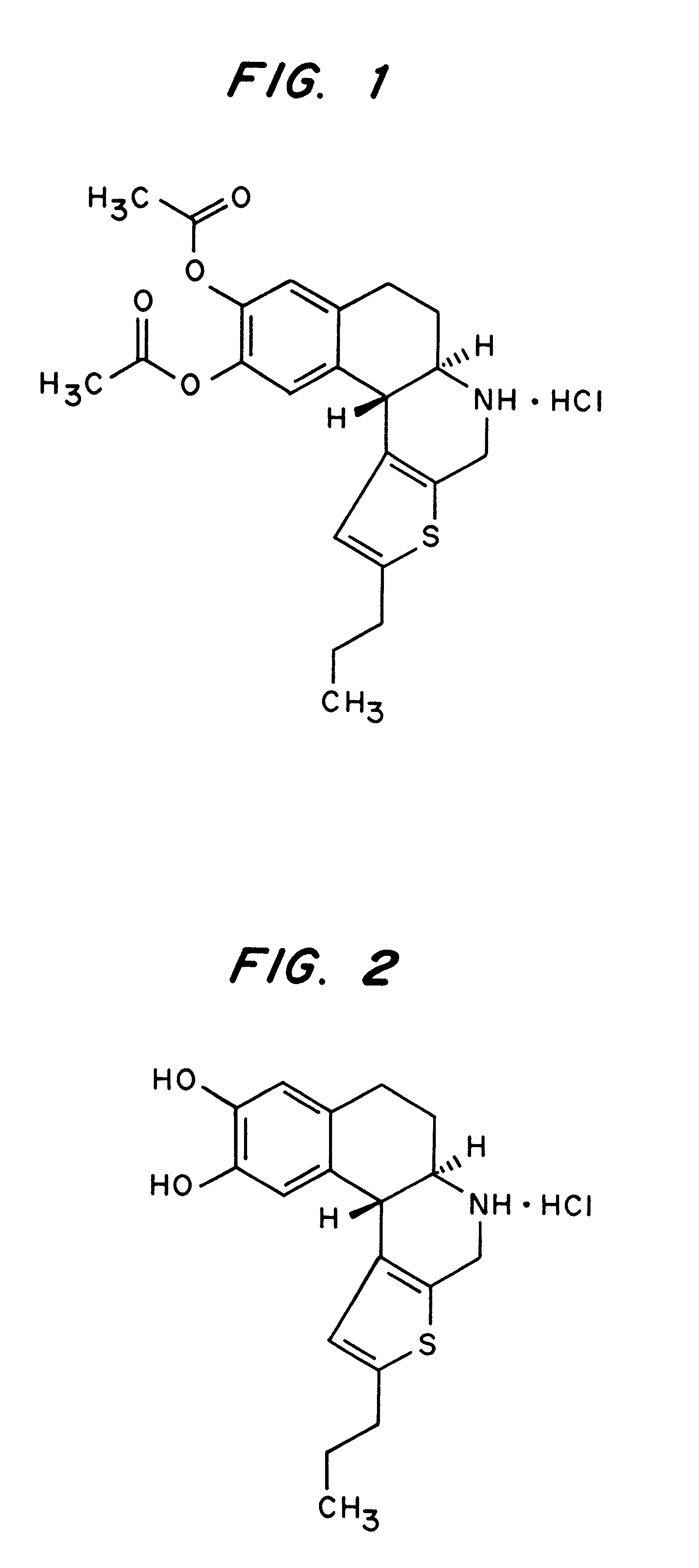Composition for the administration of a D1-agonists
a technology of d1-agonists and compositions, which is applied in the field of compositions for the administration of d1-agonists, can solve the problems of low absorption, low and erratic absorption, and unsuitability for parkinson's patients treatment, and achieve the effects of avoiding recurrence, avoiding recurrence, and avoiding recurren
- Summary
- Abstract
- Description
- Claims
- Application Information
AI Technical Summary
Benefits of technology
Problems solved by technology
Method used
Image
Examples
example 2
Chitosan Solution Formulation
A second solution formulation (Formulation B), containing the cationic absorption enhancer chitosan, was prepared. A chitosan stock solution was prepared by dissolving 100 mg of chitosan glutamate (SeaCure G210, Pronova, Norway) in 8 ml of water, adjusting to pH 4 using 0.1 M hydrochloric acid and making the volume up to 10 ml with water. In a beaker, 5 ml of chitosan stock solution, 1 ml of water and 2.5 ml of ethanol were mixed together. To this mixture was added 150 mg of A-93431.1. When the A-93431.1 had dissolved, the beaker contents were adjusted to pH 4, transferred to a 10 ml volumetric flask and made up to volume with water.
example 3
Formulation Based on Starch Microspheres
A solution containing 15 mg / ml of alpha cyclodextrin was prepared by dissolving 150 mg of alpha cyclodextrin (Sigma Chemicals, UK) in 10 ml of water. 150 mg of A-93431.1 was weighed into a 100 ml wide-necked flask. To the flask was added 10 ml of the alpha cyclodextrin solution to solubilise the A-93431.1 and 300 mg of cross-linked starch microspheres (Eldexomer.RTM., Perstorp Pharma, Sweden). The suspension of microspheres in drug solution was adjusted to pH 4 using 0.1 M hydrochloric acid and then frozen by immersing the flask in liquid nitrogen. The frozen suspension was lyophilised for 16 hours using an Edwards Modulyo freeze-drier. The lyophilised powder (Formulation C) was transferred to a glass bottle for storage.
example 4
Formulation Based on Hydroxyethyl Starch
In a 500 ml beaker, 3.125 g of hydroxyethyl starch (Leopold Pharma, Austria) was dissolved in 200 ml of water. In a 100 ml beaker, 1.5 g of A-93431.1 and 0.375 g of Eudragit RL100 (Rohm Pharma, Germany) were dissolved in 50 ml of dichloromethane. This solution was added to the hydroxyethyl starch solution and the two were mixed together for 12 minutes using a Silverson L4R high speed homogeniser, alternating between speed settings 5 and 10. The resulting emulsion was then spray-dried using a Lab Plant SD4 spray-drier (drying temperature 169.degree. C., exhaust temperature 72-81.degree. C., atomising pressure 1.9 bar, air flow setting 22, pump speed 10 ml / min) to produce a fine, white powder (Formulation D).
PUM
| Property | Measurement | Unit |
|---|---|---|
| Bioavailability | aaaaa | aaaaa |
| Bioavailability | aaaaa | aaaaa |
| Bioavailability | aaaaa | aaaaa |
Abstract
Description
Claims
Application Information
 Login to View More
Login to View More - R&D
- Intellectual Property
- Life Sciences
- Materials
- Tech Scout
- Unparalleled Data Quality
- Higher Quality Content
- 60% Fewer Hallucinations
Browse by: Latest US Patents, China's latest patents, Technical Efficacy Thesaurus, Application Domain, Technology Topic, Popular Technical Reports.
© 2025 PatSnap. All rights reserved.Legal|Privacy policy|Modern Slavery Act Transparency Statement|Sitemap|About US| Contact US: help@patsnap.com

